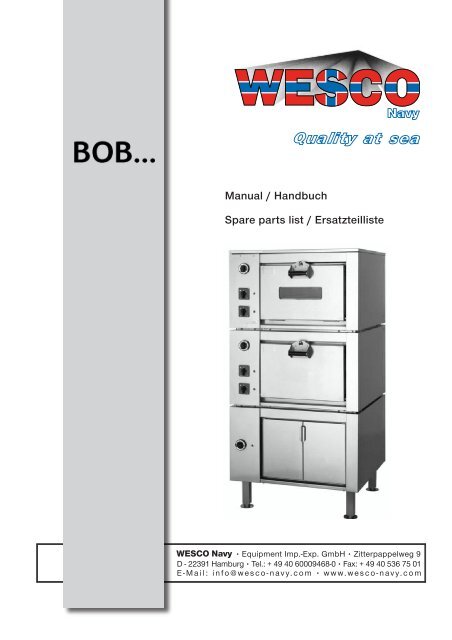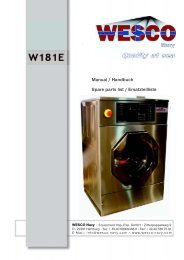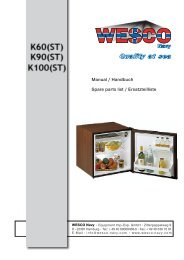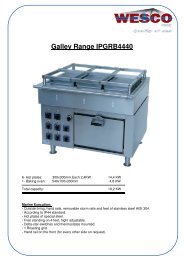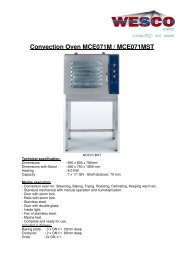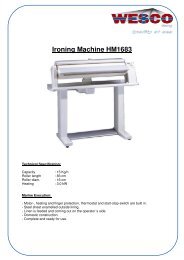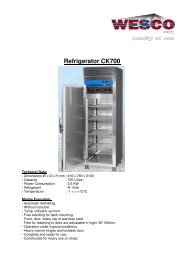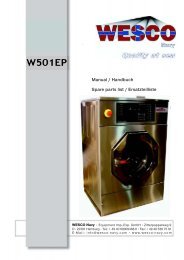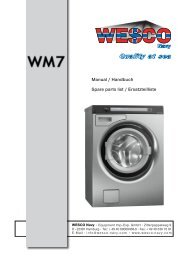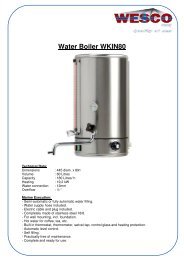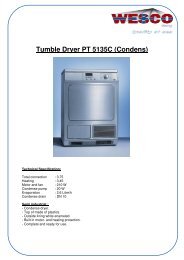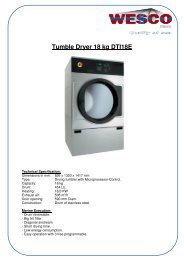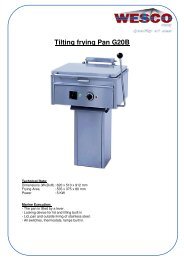Manual / Handbuch Spare parts list / Ersatzteilliste - WESCO-Navy
Manual / Handbuch Spare parts list / Ersatzteilliste - WESCO-Navy
Manual / Handbuch Spare parts list / Ersatzteilliste - WESCO-Navy
Create successful ePaper yourself
Turn your PDF publications into a flip-book with our unique Google optimized e-Paper software.
I M P O R T A N TWHEN THE UNIT SHOWS“LOW INSULATION”:IT IS NO DEFECT!!! IT IS A PHYSICAL PROCESS!!NO MANUFACTURING DEFECT!!! Please heat up the unit with MAXIMUM temperature. Go on heating, until the low insulation hasdisappeared!!!Reason: Inside the heating elements is magnesium oxide. This can absorbemoisture from the ambient air when not used for a longer time.
MANUAL 302-090105-1-004.0 FUNCTIONING RULES4.1 Hot plate connection is obtained by operating the change over delta-star switches located in the switch board panel(see drawing pages 5, 6 and 7).4.2 Each connected plate is signalled by a (red) pilot-lamp, located in the switch board panel.4.3 Plates heating adjustment is obtained by operating the delta-star switches located in the switch board panel.4.4 Oven connection is obtained operating the respective dissection switches for the upper and/or lower part of theoven, located in the switch-board panel.4.5 Heating of upper or lower part of oven is indicated by (red) pilot lamps, located in the switch-board panel.4.6 Thermic oven heating control obtained by operating the thermostat, located at the oven side (see installationdrawing) prior switch connection in the switch board panel (see drawing pages 5, 6 and 7).4.7 Avoid plates and oven connection without using them for long periods.4.8 Using the range for the first time let plates and ovens connected at the minimum temperature for few ours, thisallow remaining umidity, especially for the electric heating elements to dry up. In fact, on first connection, the earthinsulation is relatively inadequate, but is normal, after a running period proportional to the range inactivity, the insulationlevel will be normally re-established according to CEI 18-6 part 307 regulations.
MANUAL 302-090105-1-005.0 MAINTENANCE5.1 Disconnect power and make sure no one can connect power during maintenance or repair time.5.2 To avoid any problem make sure that all the different connections and heating elements will have well fastenedjunction blocks. An accurate tightening of electric wires in the junction blocks is essential for a good and durable machinefunctioning.5.2.1 To replace damaged switch, spy-lamp, thermstat please proceed as follows:5.2.2 Unfasten screws and remove front panel.5.3 Disconnect wire from junction blocks.5.3.1 Replace damaged elements.5.3.2 Reconnect wire as per wiring diagram (pages 14 – 18)5.3.3 Reconnect wire to mains as per wiring diagram (pages 14 – 18)5.3.4 Reassemble front panel5.4 For the substitution of damaged oven heating elements, proceed as:5.4.1 Open oven door5.4.2 Remove steel oven base5.4.3 Disconnect wire from heating element terminals.5.4.4 Remove damaged heating elements and replace new ones.5.4.5 Connect wire to heating element as per wiring (pages 14 – 18)5.4.6 Replace steel oven base.5.5 Oven door springs must be periodically greased for a good and lasting working time, furthermore they must becontrolled to avoid wear and tear.Access to springs from the two sides oven door panels.Maximum care is required in case of oven door spring substitution, this operation should bedone from expert personnel only.5.6 Tightening of electric junction blocks must be periodically checked. Good tightenings avoid damages to theelectric system.9
MANUAL 302-090105-1-00LEGEND DRAWINGPOS. CODE DESCRIPTION1 --- FRAME2 --- LATERAL PANEL3 --- BACK PANEL6 901165120 CORD CONNECTOR PG.21 (FOR 400 V, 415 V, 440V 480V)901165130 CORD CONNECTOR PG.29 (FOR 115 V, 230V)7 901169000 DIN BAR8 A 901169010 JUNCTION BLOCK 6 mm²(V400 V415 V440 V480)8 B 901169050 JUNCTION BLOCK CAP FOR 9011690108 C 901169020 JUNCTION BLOCK 35 mm²(V115 V230)8 D 901169060 JUNCTION BLOCKCAP FOR 9011690208 E 901169030 EARTH CONNECTION8 F 901169040 JUNCTION BLOCK FIXING9 901172350 CONTACTOR10 --- COOKING CHAMBER12 955050150 JUNCTION BLOCK13 933100001 THERMOSTAT14 901170900 BRACKET15 901175050 THERMOSTAT KNOB17 901171050 BRACKET18 901171150 SPRING19 955210060 WASHER20 955200080 NUT21 901171250 PIN22 901171400 SUPPORT HINGES BLOCK25 901190200 DOOR BAR27 902189050 LEFT PANEL29 901175010 HEATING COVER31 --- RIGHT PANEL32 HEATING ELEMENT33 901178150 DOOR HOLDER34 901178200 INTERNAL DOOR35 901178250 DOOR INSULATION36 901178500 DOOR37 901178300 DOOR HANDLE38 901178350 HANDLE39 901178400 PIN40 901178450 SCREW41 901179050 STEEL PLATE42 901172020 SWITCH44 --- DOOR GASKET45 PILOT LAMP46 911171050 CONTACTORS PANEL50 901190380 BULB COVER55 901179350 STAINLESS STEEL GRATE16
MANUAL 302-090105-1-00PREVENTIVE MAINTENANCEDAILYControl of regular functioning of various controlling apparatus (pilot lamps, thermostat, delta star switches)MONTHLYControl of feeding and derivation junction blocks.Control the wear and tear of oven door gasket.Control wear and tear of oven door movement.Regular greasing of springs.Control efficiency of fiberglass insulation wire and steatite pearls.SPECIAL TOOLSFor maintenance or cleaning special tools are not requested20
MANUAL 302-090105-1-00USEFUL ADVICES FOR STAINLESS STEEL CARE- Stainless steel is called such because its corrosion resistance is due to a thin coat of protective oxide formed on itssurface by the exposition to the air of the steel sheet.- Stainless steel is easy to clean and maintain. However, stainless does not mean non staining. Rather, it means that it willstain less.- Stainless steel is not destruction-proof, stainless equipment has been designed to give years of service.- By continually exposing it to a variety of materials they slowly eat it away, drastically reducing its life. Some materialswill do that in many ways. Some will corrode stainless, others will cause it to rust and discolour.- To help you untangle these problems we give you some useful advises that if you will follow them you will get years ofgood service from your stainless steel equipment.- Our appliance are made of stainless steel of the following two types:- Stainless steel AISI 304 (type 18/10) for external panels - tops, sinks - cooking and washing vessels.- Stainless steel AISI 430 generally for all internal panels of equipment.CLEANING AND MAINTENANCE OF STAINLESS STEEL EQUIPMENTS- Before using any detergent to clean stainless steel surfaces and floors under and around equipment, always enquireyour detergents supplier or retailer about the best products to be used for a particular cleaning.- Remember that if the steel rusts up it is not because of it but because it was not treated with proper care, and youabused by using too strong bleaches and detergent.- For cleaning and maintenance of stainless steel <strong>parts</strong> follow these rules:- Clean carefully and frequently all stainless steel <strong>parts</strong> with wet rags; soap and water or common detergents withoutabrasive slurry can be used. Rinse with pure water and dry carefully.- Cleaning is important because with a clean surface the steel will make up a protective oxide that will preventcorrosion.- When cleaning the equipment never splash water on because you can damage internal <strong>parts</strong> or components, and thiscan be very dangerous for your safety in case of electrically - heated or operated equipment.- Food spots, hardened stains. To remove it use hot sudsy water for a few minutes, then rub with a cloth, soft brush orstainless steel pad. After brushing, rinse with hot water and dry with a soft cloth.- Hard water mineral deposits. To remove it, swab or cover the area with a water solution containing vinegar orphosphoric acid. Follow this with cleansing powder, then wash and rinse.- Scratches on surface. For a high polish, apply a middy abrasive cleaner and rub in the direction of the polish lines toprevent scratches and preserve the original finish. Be careful not to rub in dirt that is on the metal surface.- To clean stainless steel never use chlorine products, like sodium hypochlorite, muriatic acids or similar ones.- These products attack soon and fast the stainless steel and produce a corrosion that can not be removed.- To clean floors under and around equipment never use the product above <strong>list</strong>ed because vapours or eventual drips onthe steel can cause corrosion problems as above explained.- Never use iron wool to clean stainless steel appliance because small particles left on its surface can get it rusted; usestainless steel wool and rub in the direction of the polish lines.- Avoid surface contact with iron materials to prevent corrosion.- Water pipes of outlet water system which feed pans, sinks, ranges, etc. produce rust, especially opening cocks after arest period, or for newly-installed plants. It is necessary to prevent these oxides or iron deposit from being in contact withstainless steel <strong>parts</strong>. It is advisable that pipes be carefully galvanised and to let water flow until it is perfect clean.- Prevent salt solution from evaporating or drying on the surface of steel. For pans do not use kitchen salt in gross grainswhich, depositing on the bottom and being too heavy, could not circulate and dissolve completely; this salt not dissolvedor dissolved in a long period, may cause corrosion in contact points. It is advisable therefore to use kitchen salt in smallgrains and put it into the pan after ebullition has begun, if it is not possible, dissolve the salt in other container.- When pans are not used, they must be kept with lid opened to maintain and activate the film protecting steel fromatmospheric oxidation.- Discoloration of stainless steel surface caused by burnt-on grease, food stains, or burns. To soften an especially heavylayer of burnt-on grease, cover it with ammonia- soaked cloth for 10 to 15 minutes. Then wash, rinse and dry. To polishburns apply a soft stainless steel wool or synthetic abrasive pad and rub in the direction of the polish lines to preventscratches.- Rust stains caused by inappropriate care and bad maintenance.Use correct products, enquire detergents manufactures ( Ex. Soilax - Diversey - Henkel - Level - Oakite - Benckiser, etc.).Rely upon recommendations of your fabricator. A good agent that has given satisfactory result for eliminating rust stainsis the Oakite 31/A, after its use rinse plentifully with water.22


